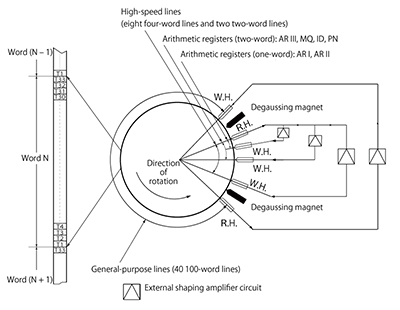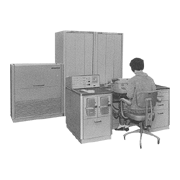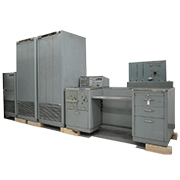The MELCOM 1101, designed primarily for scientific and engineering calculations, was completed in 1960 and was Mitsubishi Electric’s first digital computer. It featured 33-bit words, static logic, binary serial operation, a stored-program architecture, and all-transistor circuitry. The clock speed was about 214 kHz. For its logic circuit elements, the MELCOM 1101 used about 3,500 germanium transistors and about 4,000 germanium diodes. The computer had 19 different types of epoxy printed circuit boards and was put together with a total of about 750 boards.
The MELCOM 1101’s basic configuration consisted of an arithmetic and control unit, a magnetic drum memory unit, and a control console. The control console was fitted with two photoelectric tape readers capable of reading 200 to 400 characters per second, one paper tape puncher with a punching speed of 1,200 characters per minute, one I/O typewriter, and a display and control panel. The external dimensions were as follows:
| Arithmetic and control unit | 1,800 x 700 x 800 mm (h x w x d) | ||
| Magnetic drum memory unit | 1,100 x 1,000 x 800 mm (h x w x d) | ||
| Control console | 750 x 1,650 x 800 mm (h x w x d) |
It was possible to add to the basic configuration two more photoelectric tape readers, three more paper tape punchers, and four more magnetic tape memory units. The computer ran on 100 volts (±10 percent) single-phase AC at 50/60 Hz (±2 Hz) drawing about six amps or on 220 volts (±10 percent) three-phase AC at 50/60 Hz (±2 Hz) drawing about two amps. Because the MELCOM 1101 was designed around a building block structure, its functionality could be expanded dramatically by adding an arithmetic accelerator — dubbed FLORA, short for “floating point arithmetic accelerator” — and a digital differential analyzer (DDA).
The arithmetic unit, operating under the main control unit, had auxiliary controllers for input, output, and special calculations that could operate independently. This architecture meant that slow input and output processing and complex calculations, such as multiplication, division, shifts, and normalizations, could be run in parallel with easier additions, subtractions, evaluations of conditional statements, etc. With a certain amount of clever programming, the time to process calculations could be greatly reduced. For example, the INFO-3000 interpretive routine shaved between a third and a half off the time required to multiply or divide floating point numbers.
The delay-line memory drum used for memory storage had a capacity of approximately 4,000 words. It was about 30 centimeters in diameter and about 30 centimeters tall and operated at 3,600 rpm. The memory drum had independent read and write heads, numbering about 70 each. As the figure below illustrates, after data were read, they were passed through an external shaping amplifier circuit and immediately re-written to the drum by a write head. Immediately after being read, the previous memory location was demagnetized. This methodology created a line with a short wait time independent of the rotational speed. The memory drum was configured with 40 100-word lines (average access time of 7.8 milliseconds) as general-purpose memory and, as a high-speed memory, eight four-word lines (average access time of 0.31 milliseconds), six two-word lines (average access time of 0.16 milliseconds), and two one-word lines (random access).





